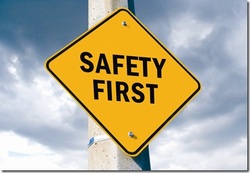CNG Vehicles are Safe.

Safety of CNG vehicles is on par or higher than gasoline vehicles. The pressurized tank is built to withstand severe impact, temperature and environment exposure. CNG lighter than air; it will evaporate quickly into the atmosphere when there is a leak instead of collecting as a puddle under the car like gasoline would.
According to the Clean Vehicle Education Foundation (USA) natural gas has very limited flammability. It will not burn at concentrations below 5% or above about 15% when mixed with air. Gasoline and diesel burns at much lower concentrations and ignite at lower temperatures.
Because compressed natural gas (CNG) fuel systems operate at pressures in excess of 3000 PSI, the fuel tank and associated plumbing have to be incredibly rugged and strong enough to contain that pressure and are made of steel up to one half-inch thick and often wrapped in protective reinforced fiberglass sheathing. Newer tanks are constructed of polymers and composites that are stronger than steel.
Contrast this with standard gasoline and diesel tanks in regular vehicles. These tanks are usually made from stamped steel shell halves, just a few thirty-seconds of an inch thick, that are welded or crimped together. In the event of a traffic accident, the ability of rugged, durable CNG tanks to withstand rupture or puncture certainly exceeds that of simple stamped steel.
The Department of Energy says vehicles powered by natural gas are as safe as conventional gasoline or diesel vehicles.
According to the Clean Vehicle Education Foundation (USA) natural gas has very limited flammability. It will not burn at concentrations below 5% or above about 15% when mixed with air. Gasoline and diesel burns at much lower concentrations and ignite at lower temperatures.
Because compressed natural gas (CNG) fuel systems operate at pressures in excess of 3000 PSI, the fuel tank and associated plumbing have to be incredibly rugged and strong enough to contain that pressure and are made of steel up to one half-inch thick and often wrapped in protective reinforced fiberglass sheathing. Newer tanks are constructed of polymers and composites that are stronger than steel.
Contrast this with standard gasoline and diesel tanks in regular vehicles. These tanks are usually made from stamped steel shell halves, just a few thirty-seconds of an inch thick, that are welded or crimped together. In the event of a traffic accident, the ability of rugged, durable CNG tanks to withstand rupture or puncture certainly exceeds that of simple stamped steel.
The Department of Energy says vehicles powered by natural gas are as safe as conventional gasoline or diesel vehicles.
